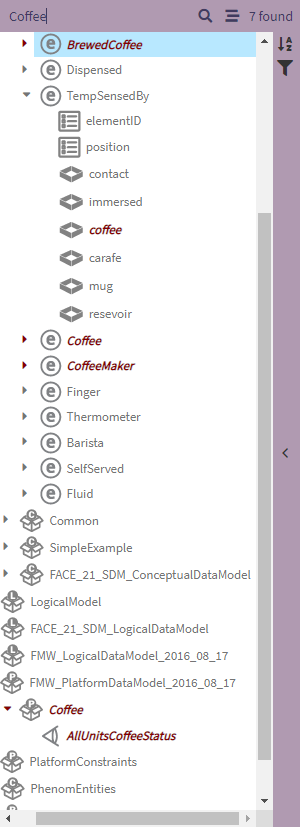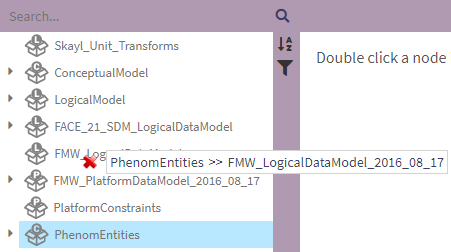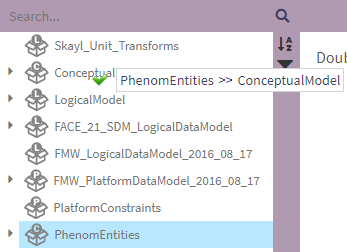NavTree: Difference between revisions
| Line 21: | Line 21: | ||
From the Nav Tree, the user can: | From the Nav Tree, the user can: | ||
* Move an element to a different package | * Move an element to a different package | ||
* Search and filter by tags or by node type | |||
* Add tags to an element | |||
* Open the details of an element to view/edit it | * Open the details of an element to view/edit it | ||
=== Moving an element === | === Moving an element === | ||
| Line 30: | Line 31: | ||
[[File:Phenom-data model-details package move bad.png|border]] [[File:Phenom-data model-details package move good.png|border]] | [[File:Phenom-data model-details package move bad.png|border]] [[File:Phenom-data model-details package move good.png|border]] | ||
=== Searching and Filtering === | |||
==== Searching ==== | |||
To search for elements by name, enter a search term on the Search Bar, and click the magnifying glass or enter to initiate the search. Elements matching the search query will be highlighted and the number of results will be displayed | |||
[[File:Phenom-navigation-navtree search.png|thumb]] | |||
To cycle through the results, the user can click on the magnifying glass or press enter. | |||
Filtering | |||
The Nav Tree filter allows finer control over what content should be displayed on the screen. Simply enter your desired filter settings, and click Apply Filter to filter down the resulting model. | |||
Collapsed | |||
Expanded | |||
Filtering Modes | |||
There are three preset modes to choose from in the filter (simply select a mode and click Apply Filter): | |||
Full - This is the Full Model, no Mode filtering applied. | |||
Model - This is the Modeling filter, it will exclude Services, Views, and their Package structure. | |||
Interface - This is the Interfacing filter, it will include Services and Views, and their Package structure, exclusively. | |||
Full Model | |||
Interface | |||
Filtering by Tag | |||
After adding tags to elements within your model, you can filter your model to display elements including/excluding specific tags. | |||
See Tagging for instructions on managing tags. | |||
See the below examples on using Include/Exclude tags: | |||
After expanding the Filter, select include or exclude (in this example we start with include), and select the tag text field to enter a new tag. | |||
Any available tags will now appear in a selectable drop-down below the text field. | |||
Typing in the text field will filter the applicable available tags. | |||
Pressing enter on a correctly typed tag, or selecting a tag from the list will add the tag to the filter. | |||
After you have added desired tag(s) in the filter, click Apply Filter. | |||
To remove tags from the current filter, select "X" on the tag. | |||
After clicking Apply Filter, the Nav Tree will reload with the filter applied. | |||
Include and Exclude tags can be applied in tandem. | |||
In the below example we're including all nodes with the "My_Vehicle_Views" tag, but excluding Views tagged as "STANAG_V2". | |||
The resulting tree will have all nodes tagged as "My_Vehicle_Views" but not tagged as "STANAG_V2". | |||
Filtering tags by "Include" returns the set of nodes containing all selected Include tags. Filtering tags by "Exclude" returns the set of nodes not containing any selected Exclude tags. Filtering by both Include and Exclude tags returns the intersection of nodes with all Include tags and without any Exclude tags. | |||
Revision as of 15:30, 20 October 2022
The Navigation Tree (NavTree for short), is the primary user interface for organizing and browsing model content.
Each Package (folder) is limited in what type of content it is allowed to contain. Conceptual packages are allowed to contain conceptual elements, Logical packages are allowed to contain logical elements, Platform packages are allowed to contain platform elements, Service packages are allowed to contain UoPs, Integration packages are allowed to contain integration elements, and Deployment packages are allowed to contain deployment elements.
Each type of data element has its own distinct icon. All icons will be shown in the following section.
Icon Library
-
Conceptual Data Model
-
Logical Data Model
-
Platform Data Model
-
Service Model Icon
-
Default icon when there is no specialized icon for the element in the tree
Nav Tree Actions
From the Nav Tree, the user can:
- Move an element to a different package
- Search and filter by tags or by node type
- Add tags to an element
- Open the details of an element to view/edit it
Moving an element
To move an element in the Nav Tree, the user can drag and drop it to the desired destination.
An element can only be moved to a package typed with the same modeling level (i.e, Observables, Entities, and Associations can only be moved to Conceptual packages; Measurements, Measurement Systems, Coordinate Systems...; can only be moved to Logical packages...). When dragging a selected element over a possible destination package/element, the destination will be displayed next to the cursor for clarity along with an icon indicating if the move is valid (a green checkmark for valid moves and a red X for invalid ones). For more details on Packages and the elements they can contain, refer to the Package page.
Searching and Filtering
Searching
To search for elements by name, enter a search term on the Search Bar, and click the magnifying glass or enter to initiate the search. Elements matching the search query will be highlighted and the number of results will be displayed

To cycle through the results, the user can click on the magnifying glass or press enter.
Filtering
The Nav Tree filter allows finer control over what content should be displayed on the screen. Simply enter your desired filter settings, and click Apply Filter to filter down the resulting model. Collapsed
Expanded
Filtering Modes
There are three preset modes to choose from in the filter (simply select a mode and click Apply Filter):
Full - This is the Full Model, no Mode filtering applied.
Model - This is the Modeling filter, it will exclude Services, Views, and their Package structure.
Interface - This is the Interfacing filter, it will include Services and Views, and their Package structure, exclusively.
Full Model
Interface
Filtering by Tag
After adding tags to elements within your model, you can filter your model to display elements including/excluding specific tags. See Tagging for instructions on managing tags.
See the below examples on using Include/Exclude tags:
After expanding the Filter, select include or exclude (in this example we start with include), and select the tag text field to enter a new tag. Any available tags will now appear in a selectable drop-down below the text field. Typing in the text field will filter the applicable available tags. Pressing enter on a correctly typed tag, or selecting a tag from the list will add the tag to the filter.
After you have added desired tag(s) in the filter, click Apply Filter.
To remove tags from the current filter, select "X" on the tag.
After clicking Apply Filter, the Nav Tree will reload with the filter applied.
Include and Exclude tags can be applied in tandem.
In the below example we're including all nodes with the "My_Vehicle_Views" tag, but excluding Views tagged as "STANAG_V2".
The resulting tree will have all nodes tagged as "My_Vehicle_Views" but not tagged as "STANAG_V2".
Filtering tags by "Include" returns the set of nodes containing all selected Include tags. Filtering tags by "Exclude" returns the set of nodes not containing any selected Exclude tags. Filtering by both Include and Exclude tags returns the intersection of nodes with all Include tags and without any Exclude tags.







